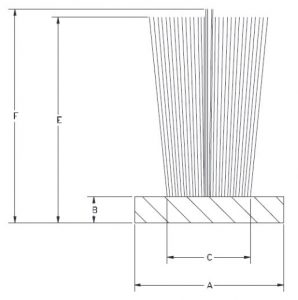In an ever-competitive global economy, today’s businesses must focus on creating high quality products while maintaining a competitive price point. In the world of textiles, alternatives to traditional woven pile methods have been developed to reduce cost, however there has been a significant trade off when it comes to quality. Finger Lakes Specialty Products continues to focus on tried and true woven pile production methods that promote long term value and customer satisfaction.
Modern technology has provided a new way to produce low cost pile products, which some manufacturers use instead of the traditional woven pile produced on looms. While this method has improved manufacturing efficiencies within the production process, it has had an adverse effect when it comes to the product’s quality. The materials used in both processes are essentially the same but the bonding methods between the pile and backer are where the new manufacturing methods clearly fall short, creating serious implications for quality and durability.
 The new method winds the pile and adheres it to the extruded backer. With this newer method, there is no guarantee that the pile will not fall out of the backer, which can lead to quality concerns. This method also has rigid pile directors in the vertical position that may interfere with the application, especially on low pile height products. In addition to quality concerns with the adherence of the backer, there are other noteworthy limitations with the newer method. Polypropylene material is the only material that can be used, where there is a limited height range, and the density cannot be altered. The only color options possible are black, white and grey.
The new method winds the pile and adheres it to the extruded backer. With this newer method, there is no guarantee that the pile will not fall out of the backer, which can lead to quality concerns. This method also has rigid pile directors in the vertical position that may interfere with the application, especially on low pile height products. In addition to quality concerns with the adherence of the backer, there are other noteworthy limitations with the newer method. Polypropylene material is the only material that can be used, where there is a limited height range, and the density cannot be altered. The only color options possible are black, white and grey.
The woven pile process has the vertical pile yarn woven together with the horizontal weft yarn. The hard or soft back coating is then applied to the woven pile. This ensures that no pile yarn can fall or be pulled out of the base. There is no gap from the base to the top of the pile yarn which results in an extremely tight seal with no interference in the application.
The traditional process offers a tight seal, while providing a great deal of flexibility to develop a product that exhibits nearly any performance characteristic the customer desires. Finger Lakes SP can weave any type of material that can be made into a fiber – polypropylene, polyester, nylon, Teflon, wool, nomex, cotton, fiberglass, ceramic, carbon filled conductive, graphite, metal, just to name a few. Blends with several different materials can also be created, and unlike the density limitations of the new method, the traditional method allows for a wide variety of densities from very light to very heavy. Color choices using the traditional woven process are also virtually unlimited.
While the new adhered pile method may initially appear more cost effective than traditional woven pile produced on looms, it is essential to consider the cost of poor quality, and the overall life of the product. If your business is focused on selling high quality, long lasting products, traditional woven pile products should be used to ensure customer satisfaction. After all, shouldn’t high quality and overall customer satisfaction always be the key driver in business? At Finger Lakes Specialty Products, we certainly think so.
For more information on the best woven pile products in the business, contact our team of experts today at sales@fingerlakes-sp.com.
